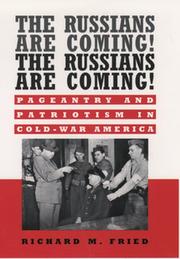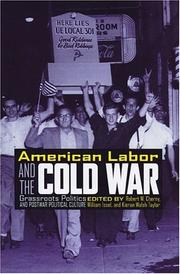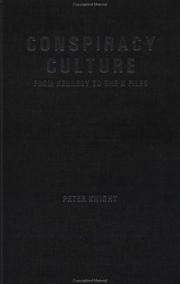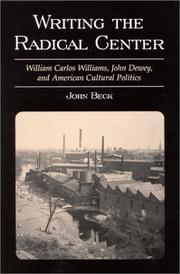| Listing 1 - 8 of 8 |
Sort by
|

ISBN: 0199923744 1423760557 0195350782 160256812X 9781423760559 9780195070200 0195070208 9780198023487 0198023480 9780195350784 0195134176 0195070208 9780195134179 Year: 1998 Publisher: New York Oxford University Press
Abstract | Keywords | Export | Availability | Bookmark
 Loading...
Loading...Choose an application
- Reference Manager
- EndNote
- RefWorks (Direct export to RefWorks)
This book explores a widely lived yet little remembered facet of America's cultural and political history: the Cold War as experienced at the grassroots level. Here, Fried traces the cresting of modern patriotic observance during World War II and then shows how patriotic and civic activists afterwards labored to recreate a remembered unity and commitment in the tension-filled Cold War era. A variety of national and local entities mounted campaigns ""to sell America to the Americans"" through ""rededication"" celebrations like Know Your America Week and Freedom Week. The American Heritage Found
Anti-communist movements -- United States -- History. --- Cold War -- Social aspects -- United States. --- Pageants -- United States -- History -- 20th century. --- Patriotism -- United States -- History -- 20th century. --- Political culture -- United States -- History -- 20th century. --- United States -- Civilization -- 1945-.

ISBN: 0195070208 9780195070200 Year: 1998 Publisher: New York Oxford Oxford University Press
Abstract | Keywords | Export | Availability | Bookmark
 Loading...
Loading...Choose an application
- Reference Manager
- EndNote
- RefWorks (Direct export to RefWorks)
Anti-communist movements --- Political culture --- Cold War --- Patriotism --- Pageants --- History --- Social aspects --- United States --- Civilization --- History. --- 20th century --- 1945 --- -Patriotism --- Anti-communist movements - United States - History --- Political culture - United States - History - 20th century --- Cold War - Social aspects - United States --- Patriotism - United States - History - 20th century --- Pageants - United States - History - 20th century --- United States - Civilization - 1945 --- -Anti-communist movements
Book

ISSN: 18697054 ISBN: 311030760X 3110338270 9783110338270 9783110372991 3110372991 9783110307603 9783110338287 3110338289 Year: 2014 Volume: 29 Publisher: Berlin Boston
Abstract | Keywords | Export | Availability | Bookmark
 Loading...
Loading...Choose an application
- Reference Manager
- EndNote
- RefWorks (Direct export to RefWorks)
Conspiracy Theories in the United States and the Middle East is the first book to approach conspiracy theorizing from a decidedly comparative and interdisciplinary perspective. Whereas previous studies have engaged with conspiracy theories within national frameworks only, this collection of essays draws attention to the fact that conspiracist visions are transnational narratives that travel between and connect different cultures. It focuses on the United States and the Middle East because these two regions of the world are entangled in manifold ways and conspiracy theories are currently extremely prominent in both. The contributors to the volume are scholars of Middle Eastern Studies, Anthropology, History, Political Science, Cultural Studies, and American Studies, who approach the subject from a variety of different theories and methodologies. However, all of them share the fundamental assumption that conspiracy theories must not be dismissed out of hand or ridiculed. Usually wrong and frequently dangerous, they are nevertheless articulations of and distorted responses to needs and anxieties that must be taken seriously. Focusing on individual case studies and displaying a high sensitivity for local conditions and the cultural environment, the essays offer a nuanced image of the workings of conspiracy theories in the United States and the Middle East.
Conspiracy theories --- Political culture --- Conspiracies --- History --- Political crimes and offenses --- History. --- Errors, inventions, etc. --- Conspiracy --- United States --- Middle East --- Civilization --- Politics and government --- Relations --- Conspiracy theories - United States --- Conspiracy theories - Middle East --- Conspiracy - United States --- Conspiracy - Middle East --- Political culture - United States - History - 20th century. --- United States - Civilization --- Middle East - Civilization --- United States - Politics and government --- Middle East - Politics and government --- United States - Relations - Middle East --- Middle East - Relations - United States --- Comparative analysis. --- Conspiracy theories. --- Middle East. --- Transnational narratives. --- United States of America.


ISBN: 081353402X 0813537134 9786613839213 0813555051 128352676X 9780813537139 9780813534022 0813534038 9780813534039 9780813555058 9781283526760 6613839213 Year: 2004 Publisher: New Brunswick, NJ
Abstract | Keywords | Export | Availability | Bookmark
 Loading...
Loading...Choose an application
- Reference Manager
- EndNote
- RefWorks (Direct export to RefWorks)
The American labor movement seemed poised on the threshold of unparalleled success at the beginning of the post-World War II era. Fourteen million strong in 1946, unions represented thirty five percent of non-agricultural workers. Why then did the gains made between the 1930's and the end of the war produce so few results by the 1960's? This collection addresses the history of labor in the postwar years by exploring the impact of the global contest between the United States and the Soviet Union on American workers and labor unions. The essays focus on the actual behavior of Americans in their diverse workplaces and communities during the Cold War. Where previous scholarship on labor and the Cold War has overemphasized the importance of the Communist Party, the automobile industry, and Hollywood, this book focuses on politically moderate, conservative workers and union leaders, the medium-sized cities that housed the majority of the population, and the Roman Catholic Church. These are all original essays that draw upon extensive archival research and some upon oral history sources.
Anti-communist movements -- United States -- History. --- Cold War. Political culture -- United States -- History -- 20th century. --- Labor unions -- Political activity -- United States -- History -- 20th century. --- United States -- Politics and government -- 1945-1953. --- United States -- Politics and government -- 1953-1961. --- Labor unions --- Anti-communist movements --- Cold War --- Political culture --- Business & Economics --- Labor & Workers' Economics --- History --- Political activity --- Industrial unions --- Labor, Organized --- Labor organizations --- Organized labor --- Trade-unions --- Unions, Labor --- Unions, Trade --- Working-men's associations --- Culture --- Political science --- World politics --- Labor movement --- Societies --- Central labor councils --- Guilds --- Syndicalism --- United States --- Politics and government --- E-books --- Cold War. --- History.

ISBN: 0415189772 0415189780 9780415189781 9780415189774 Year: 2000 Publisher: London Routledge
Abstract | Keywords | Export | Availability | Bookmark
 Loading...
Loading...Choose an application
- Reference Manager
- EndNote
- RefWorks (Direct export to RefWorks)
Sociology of culture --- United States --- Popular culture --- Political culture --- Conspiracies --- Paranoia --- Cold War --- History --- Social aspects --- Civilization --- Social conditions --- 20th century --- 1945 --- -United States --- -Conspiracies --- #SBIB:014.AANKOOP --- #SBIB:309H040 --- #SBIB:316.7C140 --- Populaire cultuur algemeen --- Cultuursociologie: cultuur en globale samenlevingen --- Psychology, Pathological --- Psychoses --- Popular culture - United States - History - 20th century --- Political culture - United States - History - 20th century --- Conspiracies - United States - History - 20th century --- Paranoia - Social aspects - United States - History - 20th century --- Cold War - Social aspects - United States --- United States - Civilization - 1945 --- -United States - Social conditions - 1945 --- -Cold War --- -Popular culture --- United States of America

ISBN: 0791451208 0791451194 9780791451199 9780791451205 Year: 2001 Publisher: Albany (N.Y.) : State university of New York press,
Abstract | Keywords | Export | Availability | Bookmark
 Loading...
Loading...Choose an application
- Reference Manager
- EndNote
- RefWorks (Direct export to RefWorks)
"Placing the philosopher John Dewey and the poet William Carlos Williams together - two important figures of twentieth-century American culture - this book examines the ambitions and failings of progressive liberal culture during the first half of the twentieth century. This book shows that, while their work ostensibly shares little in common, Williams and Dewey share the ambition to realize the radical potential of a democratic cultural politics. Including close readings of texts like Williams's Spring and All, In the American Grain, and Paterson, and Dewey's Individualism Old and New and Art as Experience, Beck offers an important contribution to current debates over the relationship between politics and cultural production."--BOOK JACKET.
Politics and culture --- Politics and literature --- Political culture --- Radicalism --- Political poetry, American --- History --- History and criticism. --- Politique et littérature --- Radicalisme --- Poésie politique américaine --- Culture --- Culture politique --- Politik --- Literatur --- Kultur --- Political and social views. --- Political culture. --- Political poetry, American. --- Political science. --- Politics and culture. --- Politics and literature. --- Radicalism. --- Histoire --- Histoire et critique. --- Aspect politique --- Williams, William Carlos, --- Dewey, John, --- Williams, William Carlos --- Dewey, John --- Pensée politique et sociale. --- Et la science politique. --- 1900-1999. --- United States --- États-Unis --- United States. --- Politics and government --- Politique et gouvernement --- Politik. --- Literatur. --- Kultur. --- Williams, William Carlos. --- Dewey, John. --- Politics and culture - United States - History - 20th century. --- Politics and literature - United States - History - 20th century. --- Political culture - United States - History - 20th century. --- Radicalism - United States - History - 20th century. --- Political poetry, American - History and criticism.
Book
ISBN: 0773416994 9780773416994 9780773450745 0773450742 Year: 2008 Publisher: Lewiston, N.Y. Edwin Mellen Press
Abstract | Keywords | Export | Availability | Bookmark
 Loading...
Loading...Choose an application
- Reference Manager
- EndNote
- RefWorks (Direct export to RefWorks)
This work investigates the use of sport in the first two decades of the Cold War to resist Communism by strengthening the American Way of Life. Each of the Cold War's key players used athletics as a means of advancing political ideologies. The book also evaluates the gains and losses of minorities in this era.
Cold War -- Social aspects -- United States. --- National characteristics, American -- History -- 20th century. --- Political culture -- United States -- History -- 20th century. --- Propaganda, Anti-communist -- United States -- History -- 20th century. --- Sports -- Political aspects -- United States -- History -- 20th century. --- Sports -- Social aspects -- United States -- History -- 20th century. --- Sports and state -- United States -- History -- 20th century. --- United States -- Politics and government -- 1945-1989. --- United States -- Social conditions -- 1945-. --- Sports --- Sports and state --- Cold War --- Propaganda, Anti-communist --- Political culture --- National characteristics, American --- Social Sciences --- Recreation & Sports --- Anti-communist propaganda --- Anti-communist movements --- Propaganda, Capitalist --- World politics --- Field sports --- Pastimes --- Recreations --- Recreation --- Athletics --- Games --- Outdoor life --- Physical education and training --- Sports policy --- State and sports --- History --- Political aspects --- Social aspects --- Government policy --- United States --- Politics and government --- Social conditions
Book
ISBN: 0773429522 9780773429529 9780773437029 0773437029 Year: 2010 Publisher: Lewiston : The Edwin Mellen Press,
Abstract | Keywords | Export | Availability | Bookmark
 Loading...
Loading...Choose an application
- Reference Manager
- EndNote
- RefWorks (Direct export to RefWorks)
This study investigates how. for the first time the new medium of radio impacted upon a presidential campaign. Prior to 1924 candidates were known to the public by their photographs and by the printed versions of their major speeches published in the press. Beginning in 1924, however, party standard-bearers were recognized by their voices.
Communication in politics -- United States -- History -- 20th century. --- Coolidge, Calvin, 1872-1933. --- Political campaigns -- United States -- History -- 20th century. --- Political culture -- United States -- History -- 20th century. --- Presidential candidates -- United States -- History -- 20th century. --- Presidents -- United States -- Election -- 1924. --- Radio broadcasting -- Political aspects -- United States -- History -- 20th century. --- Social change -- United States -- History -- 20th century. --- United States -- Politics and government -- 1923-1929. --- Presidents --- Radio broadcasting --- Communication in politics --- Political culture --- Social change --- Presidential candidates --- Political campaigns --- Regions & Countries - Americas --- History & Archaeology --- United States - General --- Candidates for president --- Nominees for president --- Presidential nominees --- Political candidates --- Radio --- Radio industry and trade --- Broadcasting --- Mass media --- Presidency --- Heads of state --- Executive power --- Election --- Political aspects --- History --- Coolidge, Calvin, --- United States --- Politics and government --- Coolidge, Calvin --- Coolidge, John Calvin,
| Listing 1 - 8 of 8 |
Sort by
|

 Search
Search Feedback
Feedback About UniCat
About UniCat  Help
Help News
News